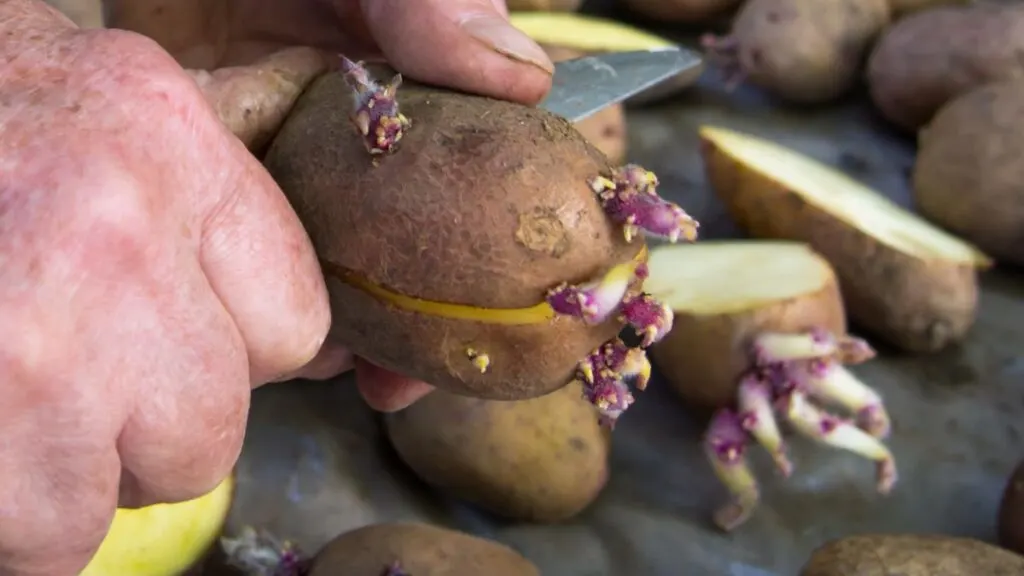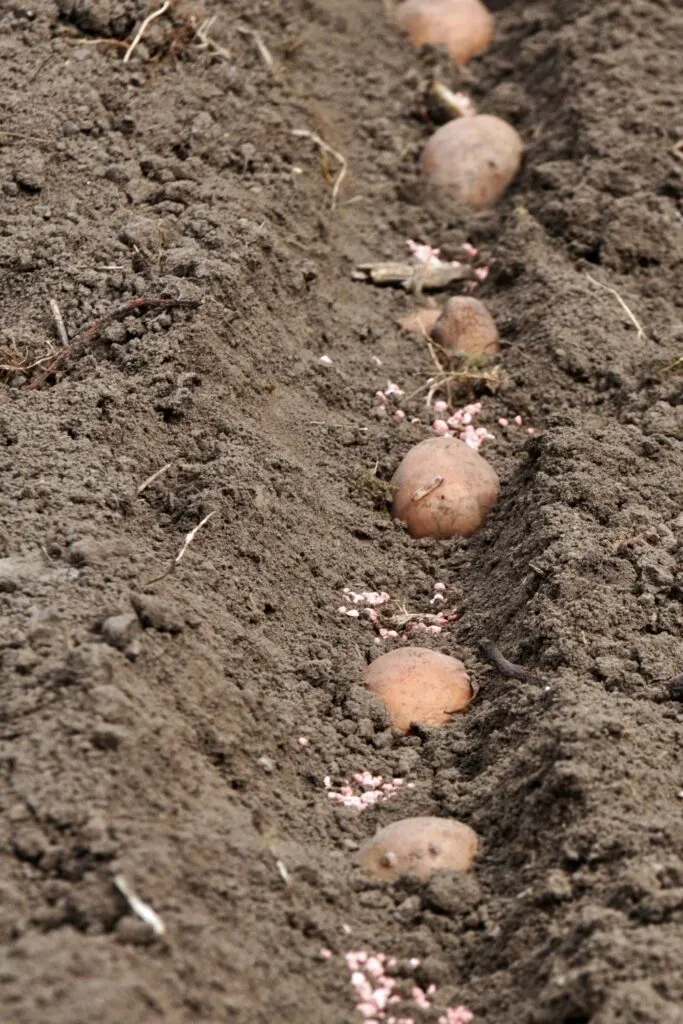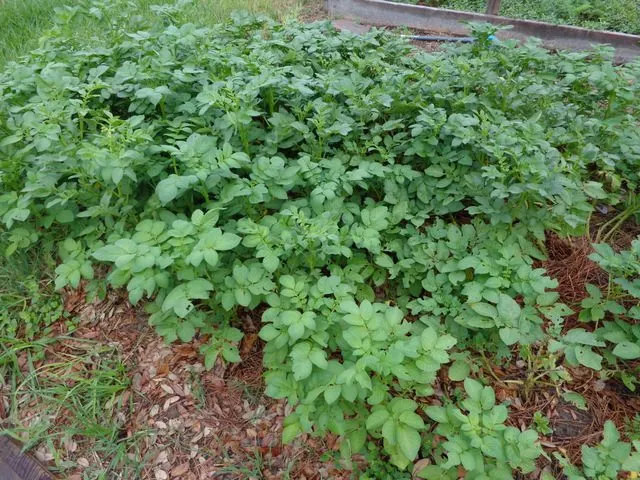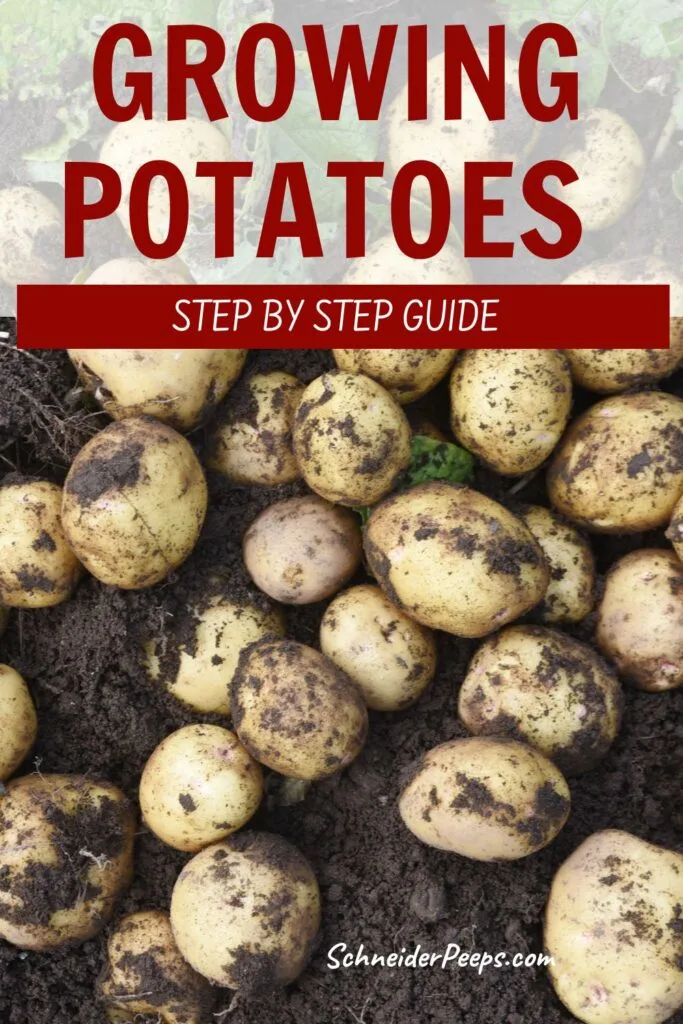Growing potatoes in the home garden is a really fun project. Potato plants require sun, well-drained soil and regular water, if you can give them those things, you can grow almost any potato variety.
If you’re short on garden space, potatoes can be grown in containers or grow bags.

True Potato Seeds or Seed Potatoes?
While it is possible to grow potatoes from the seeds the flowers make (these are called true potato seeds), you’ll get more reliable results if you grow potatoes from tubers that have sprouted.
If you’re interested in learning more about true potato seeds, Grand Tetons Organics has a great article about them and also sells them.
You can find tubers for planting (certified seed potatoes) at garden centers and local feed stores. Most non-organic grocery store potatoes are sprayed with an inhibitor to keep them from sprouting, so those don’t make great seed potatoes. That being said, I’ve successfully grown potatoes from grocery store potatoes. I don’t have a problem, planting ones that sprout in my kitchen in the early spring.
When to Plant Potatoes
Potatoes are a cool-season crop so they are usually planted in early spring, however, in warmer regions you can also plant fall potatoes and get a second harvest.
For spring planting, the soil temperature needs to be above 45 degrees Fahrenheit before planting potatoes. Potatoes can handle a light frost, there might be some leaf damage but the underground parts will be fine.
For fall planting, planting time is 110 days before your average first frost. There is no upper limit on soil temperature for growing fall potatoes.
Best Soil For Growing Potatoes
The best garden soil for growing potatoes is one that is rich in organic matter and not compacted. If you have clay soil, you’ll need to break it up with compost, peat moss, or even by adding some sand to it. Since the tubers grow underground, you want the really loose soil to give them room to grow and good drainage so they don’t rot.
While potatoes can tolerate a variety of soil conditions, you’ll get best results in slightly acidic soil with a pH of 6-6.5 but will tolerate soil with a pH as low as 5.

How to Plant Potatoes from Eyes
You know those little indentions on potatoes? Those are called eyes, and that’s where the potato sprouts from. If you’re buying seed potatoes locally, look for ones that have already sprouted, it will save you a step. If you’ve ordered seed potatoes and they haven’t sprouted, no worries, they’ll sprout soon enough.
If the potatoes haven’t sprouted when you get them, put them in a warm, sunny spot until they sprout. You’ll want to do this several weeks before you plan to plant them. Forcing potatoes to sprout is called chitting and it can help you have a larger harvest.
- With a clean knife, cut the potatoes into large pieces that have at least 2 eyes on each piece. Smaller potatoes can be left whole. The potato will feed the sprout until the plants roots develop.
- Lay the seed potato pieces out, cut side up, for a few days in a warm spot. This will “cure” the potato and help reduce the chances of the potato rotting. According to the University of Maryland, “You can also help prevent disease and insect injury by coating the seed pieces with elemental sulfur (place seed pieces and the sulfur in a bag and shake).” Or the pieces can be dipped in wood ash to coat the cuts and prevent rotting and disease. However, do not use wood ash to amend the soil, it’s too alkaline for growing potatoes.
- Prepare the garden bed or container that you’re going to grow potatoes in.
- Dig a trough about 6 inches deep and 4 inches wide.
- Plant the potato pieces with the cut side down and the sprouts sticking up.
- Cover the potato pieces with about two inches of soil.
- Water when needed, potato plants need about an inch of rain a week.
Growing Potatoes
As the potatoes plants grow, you’ll want to “hill” them by mounding soil around the plant. This will help them make more potatoes. When the plants are about 8 inches tall, cover all but the top 4 inches with soil, chopped hay or shredded leaves. When they grow to 8 inches again, bury all but the top 4 inches. Keep repeating this process until the plants flower.
You want to make sure that the potato tubers are never exposed to sun. The sun can cause green spots which are a sign of
solanum tuberosum in the potato. You should not eat potatoes with green spots or feed them to your animals.
Water the potato plant regularly. Don’t let them dry out and then flood them.

When to Pick Potatoes
You can pick “new” potatoes at any time during the growing season. These early potatoes are perfect for boiling or roasting. You’ll know it’s harvest time when the potato plants die. At this point, you’ll reach into the loose soil and dig the potatoes. This is a super fun activity, especially for children. Use a digging fork and not a shovel to loosen the soil to dig potatoes out of the soil.
Different potato varieties can take anywhere from 90 to 120 days from the time of planting until the it’s time to harvest potatoes
How to Grow Potatoes in Containers and Bags
A lot of people grow potatoes in containers or grow bags. I’ve tried growing potatoes in containers but containers need to be watered more often which I struggle with, so they don’t do well for me.
If you want to try growing potatoes in the containers or grow bags, they process is exactly the same as growing potatoes in ground or in a raised bed. Just follow the process above. Water them whenever the top inch of the soil is dry.

Potato Pests and Problems
Probably the biggest potato pest is the Colorado Potato Beetle. They will lay a cluster of orange eggs on the underside of the leaves, you can remove these leaves and burn them (or just squish the eggs.). Ladybugs will eat potato beetle eggs so be sure to attract beneficial bugs to your garden.
If you know potato beetles are a problem in your area, you can use row covers to protect them. Just be sure to put the row covers over the growing area right after planting the potatoes. Since potatoes are root vegetables, they don’t need pollinators produce potatoes.
Potato blight can wipe out entire crops of potatoes, remember the Irish potato famine? To avoid spreading, use a 3 year rotation schedule – don’t plant potatoes where other nightshade plants have been planted during the previous 3 years. Nightshade plants are tomatoes, eggplant and peppers.
Storing Potatoes
Once the potatoes are harvested, lay them out in the shade for a day or two to let the skin harden. Don’t wash the potatoes before storing them, just wipe off the dirt.
To fully cure potatoes for storage, put them in a humid place at 55 degrees Fahrenheit for two weeks.
Once cured, potatoes can be stored in burlap bags or buckets with sand in a cool, dry place like a root cellar or unheated basement. Don’t store potatoes with apples or they will prematurely sprout.
Because I live in a warm climate, I cannot store spring potatoes from their harvest date in June all through the winter. Therefore, I rely on planting a fall potato crop to carry us through the winter. I also can potatoes to ensure none go to waste.


Dianne
Wednesday 20th of March 2024
I am in zone 9a and planted organic potatoes from our store in grow bags. For a month or two, they were thriving with lush green leaves. All of a sudden, I noticed some brown spots forming and tried to use copper fungicide while pulling off and destroying all bad leaves. The next day, they were wilted and I found "rolly polly" (aka potato bugs) in the bag. I didn't know what to do but read some articles online that advised me to chop all the foliage and let the potatoes sit for a few weeks. I haven't dug them up yet.
I'm wondering if they didn't turn out because I just planted a whole potato with sprouts? Or because I didn't use a seed/tuber?
If you have any advice, I will gladly take it. Your blog has been such a help to me!
Angi Schneider
Thursday 21st of March 2024
There's a lot to think about here. The potato plants will die back when it's time to harvest the potatoes. But it seems like it's too early for that. If you chopped all the foliage, I don't know that they will grow more greens. They need the greens to make new tubers.
I wonder if the brown spots were some kind of blight? Ideally, you want to plant certified seed potatoes to reduce the risk of disease. I've planted grocery store potatoes that have sprouted without any problems but you'll get better results by using seed potatoes. If so, it's best to not plant potatoes or any other nightshade plant in that soil.
Lastly, rolly pollies are scavengers and help decompose organic matter and break it down. I have had "infestations" when I've used compost that wasn't fully composted down and the bugs will attack green matter. Here are some ideas for getting rid of them.
Alycia
Saturday 29th of November 2014
Are sweet potatoes more difficult to harvest than other kinds? Any tips for them? I am most interesting in getting a huge crop of them then any other kind.
Angi Schneider
Tuesday 2nd of December 2014
No, they aren't hard to havest. Just make sure to plant them in loose soil. The first year we planted them was the first year we lived here and the soil has so much clay, they were hard to dig out. They need alot of room for the vines. They grow differenly than regular potatoes.
Karen Coghlan
Friday 9th of May 2014
Hello,, I am so interested in growing potatoes,,,
We planted some red, russet, and sweet potatoes for the first time this year... The Red and Russets have already been harvested, we dug them up earlier than we planned, the reason was that the top foliage began to die and I got nervous and wanted to see what was going on,, when I started to dig them up, and found a few nice sized red potatoes, I could not stop and un-earthed them all, except the sweet potatoes..
We found some small and some larger russets in addition to the red... We only planted 6 potatoes of each red and russet,, but harvested about 5 lbs, not a lot but it was wonderful to see our first ever home grown potatoes,, my daughter said that the small ones would be nice roasted...
After digging our potatoes, some of the foliage had roots and looked like they could be replanted so that is what we did,, we replanted the potato plants that had foliage and roots... Wondering what we will get...
Angi Schneider
Monday 12th of May 2014
How fun. I'm intersted in seeing what happens to those replanted potatoes, too. I usually wait for the plants to completely die back before harvesting. I wonder if you can get two plantings where you live? We're going to try that this year - we never seem to harvest enough potatoes.
The Schneiders
Monday 11th of July 2011
Thanks, Jackie. Potatoes were so easy to grow. I was amazed at how much better they are than store bought.
Jackie
Monday 11th of July 2011
This is great info. This is my first year to plant regular potatoes.